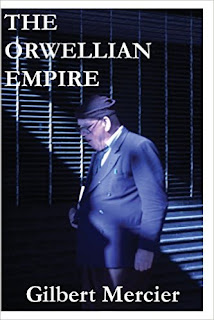Mickey Z. -- World News Trust
Nov. 22, 2015
Since the Paris attacks, I’ve noticed a predictable proliferation of the word “mastermind” in corporate media reports.
I say
predictable because whenever the “good guys” take a hit, it’s essential
to the narrative that their opponent be presented as some kind of evil
genius who has dealt them a temporary setback that will only serve to
bring out the best in them. In this case, of course, the masterminds are
ISIS in general and was Abdelhamid Abaaoud, in particular.
This is how
males do things (sports, business, war, etc.). Even when we’re clueless
or merely engaging in violence for sheer pleasure (translation: almost
always), we have to present the illusion that we’re in the midst of some
kind of epic, noble mission. This clip from Gangs of New York helps illustrate what I’m trying to describe:
You see, bad
guys are to be respected if for no other reason than to make the good
guys even more impressive for having taken them on. For example, heroic
war criminal George S. Patton studied the strategies of vile war
criminal Erwin Rommel and thus found a rival worthy of the name. It
makes for iconic Hollywood moments, for sure:
Such
self-delusion and denial has financial value beyond the box office. When
facing off against an evil genius, it takes a benevolent (well-armed)
genius to prevail. Enter the precision myth, the widespread belief -- all across the political spectrum -- that U.S. technology allows for “surgical strikes” and “pinpoint” bombing, all in the name of good.
This is where
profit margins come into play. With roughly half of U.S. Federal tax
dollars used to fund a global killing spree known as the U.S. Department
of Defense (sic), this expenditure must be justified in order make certain the next fiscal quarter pleases investors.
Since Americans
want so badly to believe their tax dollars are being used to crush evil
doers but also would (usually) prefer that such crushing doesn’t (if
possible) involve the wanton slaughter of, say, children and other
civilians, the smart bomb myth is promoted through a variety of spins,
e.g. U.S. weapons are the most technologically advanced and precise the world has ever seen.
Like all spin,
evidence to the contrary is not hard to find. So, please allow me to
take you through a very brief and recent history of the masterminds
behind precision bombing.
Define “Precision”
Good (sic) War Fun Fact: During World War II, Allied bombing raids killed 672,000 Japanese civilians and 635,000 German civilians.
U.S.
bombers in the European theater initially stuck to a policy of daylight
“precision” bombing but the risks of daytime runs did not pay off in
accuracy -- only 50 percent of U.S. bombs fell within a quarter of a mile of the target.
America soon joined its English allies in the execution of nighttime
area bombing campaigns of civilian targets in Germany and later, Japan.
Day or night,
the number of shells falling where they were not aimed easily debunked
the myth of precision. "In order to invade the Continent," says
historian Paul Fussell, "the Allies killed 12,000 innocent French and
Belgian civilians who happened to live in the wrong part of town, that
is, too near the railway tracks."
Subsequent
technological “progress” has offered no relief for those in war zones.
What is euphemistically known as "friendly fire" or "collateral damage"
is still a mainstay of war. In fact, as war became more technologically
advanced, civilian casualties did not decrease.
Delay the news until it no longer matters
All throughout Operation Desert Storm, the Pentagon and an acquiescent
media sold the American public on the accuracy and efficiency of U.S.
weaponry.
"Although influential media such as the New York Times and Wall Street Journal
kept promoting the illusion of a 'clean war,'" write media critics
Martin A. Lee and Normon Solomon, "a different picture began to emerge
after the United States stopped carpet-bombing Iraq. The pattern
underscored what Napoleon meant when he said that it wasn't necessary to
completely suppress the news; it was sufficient to delay the news until
it no longer mattered."
That delay
lasted from February 1991 until July 1996 when the General Accounting
Office released a study that found the claims made by the Pentagon and
its principal weapons contractors concerning the pinpoint precision of
the Stealth fighter jet, the Tomahawk land-attack missile, and
laser-guided smart bombs "were overstated, misleading, inconsistent with
the best available data, or unverifiable."
"The accounting office concluded," wrote Tim Weiner in the New York Times, "that new, costly 'smart' weapons systems did not necessarily perform better than old-fashioned, cheaper 'dumb' ones."
"When
laser-guided bombs miss, it means that something got screwed up in the
control mechanism, so they can go 10 miles away; they can go anywhere,"
adds Noam Chomsky. "No high-technology works for very long, certainly
not under complicated conditions."
“The public and the Congress were misled”
On Jan. 22, 1991, ABC-TV reporter Sam Donaldson reported on an alleged
Patriot Missile intercept. "A Scud missile is heading toward Dharan in
eastern Saudi Arabia," Donaldson said as the screen showed a bright
object rocketing across the sky. "And rising to intercept it, a U.S.
Patriot missile." After a beat, Donaldson gleefully cheered, "Bullseye!
No more Scud!"
"But on the
screen," says Jennifer Weeks, a defense analyst with the Congressional
Arms Control and Foreign Policy Caucus, "the Scud seems to continue
right through an explosion on its path toward the ground."
The U.S. Army
told Congress that Patriot missiles had intercepted 45 of the 47 Scuds
at which they were fired. "Desert Storm provided gripping images of
Patriots arcing across the night skies over Israel and Saudi Arabia to
intercept Iraqi Scuds, and U.S. officials quickly claimed that the
Patriot (originally designed to shoot down airplanes and slow-flying
cruise missiles) was effective against ballistic missiles," says Weeks.
President George
H.W. Bush visited the Raytheon plant in Andover, Massachusetts, where
the Patriot is made. "Patriot is proof positive that missile defense
works," the president declared -- and the matter appeared to be settled.
Theodore A.
Postol is professor of science, technology, and national security policy
at the Massachusetts Institute of Technology. "The current National
Missile Defense interceptor tries to identify warheads and decoys by
'looking at them' with infrared eyes," Postol wrote in a June 15, 2002, Boston Globe op-ed, explaining:
"Because
the missile defense is essentially using vision to tell which objects
are decoys and which are bombs, this technique is no more effective than
trying to find suitcase bombs at an airport by studying the shape and
color of each suitcase."
A 1992 report by a House of Representatives Operations of Government subcommittee concluded:
"The
Patriot missile system was not the spectacular success in the Persian
Gulf War that the American public was led to believe. There is little
evidence to prove that the Patriot hit more than a few Scud missiles
launched by Iraq during the Gulf War, and there are some doubts about
even these engagements. The public and the Congress were misled by
definitive statements of success issued by administration and Raytheon
representatives during and after the war."
Even then-Secretary of Defense (sic) William S. Cohen, in January 2001 eventually confessed, "The Patriot didn't work."
A Bridge Too Fake
This pattern held during the 78-day bombing campaign over Yugoslavia in
1999. During the assault, Defense Secretary William Cohen declared: "We
severely crippled the (Serbian) military forces in Kosovo by destroying
more than 50 percent of the artillery and one-third of the armored
vehicles."
One year later, a U.S. Air Force report revealed a different story:
Original Claim: 120 tanks destroyed
Actual Number: 14
Original Claim: 220 armored personnel carriers destroyed
Actual Number: 20
Original Claim: 450 artillery pieces destroyed
Actual Number: 20
Original Claim: 744 confirmed strikes by NATO pilots
Actual Number: 58
The report also
found that Serbian military fooled U.S. technology with simple tactics
like constructing fake artillery pieces out of black logs and old truck
wheels. One vital bridge avoided destruction when a phony was
constructed out of polyethylene sheeting 300 yards upriver. NATO pilots
bombed the fake bridge several times.
There are no masterminds here
In advertising campaigns not unlike those hawking SUVs or cell phones,
alleged American military technical superiority (and the related benefit
to avoiding civilian casualties) is packaged, marketed, and sold to a
far-too-willing nation.
Fighter jets
perform flyovers at sporting events. Hollywood deifies weapons of war.
Politicians from all sides support "defense" spending. War toys sanitize
the impact of such spending and desensitize children to the cause and
effect of military action.
In the end,
however, it’s men who manufacture these weapons and men who utilize
them. Men collude to delude themselves about how smart they, how
advanced their weapons and tactics are, and how noble their intentions
are. Their behavior is, in a word: pathological.
“Leadership positions,” writes Kathleen Barry in Unmaking War, Remaking Men,
“are feeding ground for psychopaths, attracting as they do those
cunning leaders who are indifferent to human life and absent of
remorse.”
The mastermind
we revere appears decisive and strong simply because he doesn’t give a
shit about outcomes other than ego, profit, and personal power. His
smart bombs aren’t smart. His precision is imprecise. His honorable
intentions are dishonorable. There simply are no masterminds within such
a predatory paradigm.
There can be no
peace in a society like this just as there can be no peace as long as
patriarchy reigns and the relentless war on woman continues to rage. The
only mastermind worthy of the title would be someone, anyone who conjures up ways to smash the hierarchies and end the violence.
My educated guess is that such a mastermind would undoubtedly be female.
 "Masterminds vs. Smart Bombs: Men Waging War"
"Masterminds vs. Smart Bombs: Men Waging War" by
Mickey Z. is licensed under a
Creative Commons Attribution-ShareAlike 4.0 International License.
Based on a work at
http://worldnewstrust.com/masterminds-vs-smart-bombs-men-waging-war-mickey-z.















